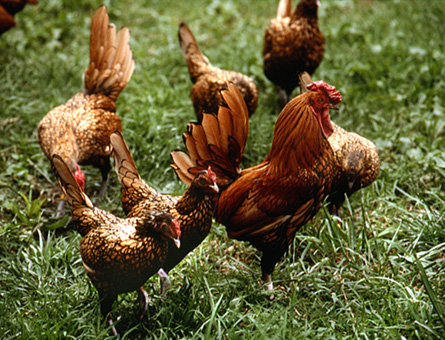Alarming sex appeal
Roosters that call out in alarm prove popular with the hens
Normal 0 false false false MicrosoftInternetExplorer4 In the long run it’s not a guy’s looks that count. It’s his little clucks in the face of danger.
A high rate of calling out in alarm turns out to be one of the clearest signs of a rooster with a successful sex life, says Chris Evans of MacquarieUniversity in Sydney, Australia. A rooster that readily gives warning calls when danger looms tends to rank high in number of times hens accept him as a mate and in number of chicks sired, Evans, David R. Wilson and colleagues report in the September Animal Behaviour.

A rooster may waggle a huge, ruby-red comb at hens, but if they’ve had a chance to get to know him, his splendor doesn’t mean success. In tests that mimic real life among fowl, behavior trumps looks.
“As far as I know, their paper is the first to address the sexiness of alarm calling,” says Dan Blumstein of the University of California, Los Angeles, who has studied alarm calls in marmots.
“Alarm calling is a classic problem in evolutionary biology,” Evans says. Squawking as a hawk circles or a fox sneaks up raises the chances of the squawker getting eaten. While the rest of the neighborhood may benefit, the alarm caller seems to be taking a puzzling altruistic risk.
For 20 years now, Evans has been studying alarm calls in golden Sebright fowl, the same Gallus gallus species as industrially farmed chickens, but with the behavior of wild birds. The fowl give two kinds of alarm calls: a string of “tuk tuk” clucking for a terrestrial predator and a whistley call for airborne danger.
Before Evans’ work, only primates had been known to give these referential calls, the animal equivalent of “Predator above!” instead of just an “Eeeeaaaaahhhh!” that communicates fear.
Evans says he is working toward understanding how the calls affect the lives of the birds and, eventually, how the alarms evolved.
Clucks of warning might work as show-off heroics, Evans speculates. Alarm-calling roosters could be males in such fine fettle that they can afford to take a little extra risk. However, he says, so far he just has the correlation between calling and mating, not evidence for which leads to the other.
In another proposed scenario, calls are the risks a dad takes to improve the chances his offspring will survive. In support of this idea, Evans cites more research not yet published that finds mated roosters giving 30 percent more alarm calls than males that haven’t had their chance yet.
The two possibilities aren’t mutually exclusive, Evans says. The protective-dad effect still allows room for alarm calling as seductive gestures in their own right.
A triumph of behavior over looks might seem like an outright contradiction of earlier studies, but Evans offers an explanation. Laboratory tests that offer hens a choice of two unfamiliar roosters find that females choose males with big, colorful combs, he says. But outside the lab, fowl spend their lives in social groups, and hens hardly ever encounter unfamiliar males.
Evans and his colleagues set up more realistic tests, starting in 1999. Researchers put sets of three roosters and three hens into big pens and allowed days for the birds to work out dominance hierarchies and get to know each other. Then for almost two weeks, researchers monitored bird behavior from clucking to mating and recorded physical traits. “We measured everything we could think of,” Evans says.
In a large statistical analysis, the research team looked for factors that went along with either frequent mating or a large share of the chicks. In the end, dominance in the male hierarchy mattered for mating success, which wasn’t a surprise. Independent of dominance though, high rates of alarm calling also marked a favored male.
For animals in stable social groups, Blumstein says, “behavior can be sexy.”